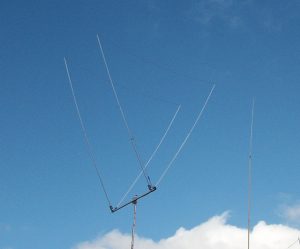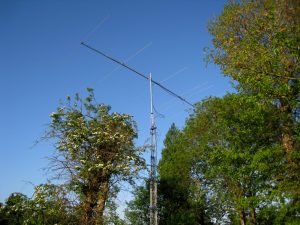EZNEC – Friend or Foe?
There’s oddities between NEC/2 versions
You’d expect your new antenna modelling software package to be your best mate in the shack. But unfortunately that won’t always be the case. Why? I hear you ask. Well – EZNEC comes in more than one flavour.
Pre January 1st 2022, EZNEC came in a variety of 4 guises.
The basic EZNEC software which includes EZNEC [$99], EZNEC+ [$149] and EZNEC Pro/2 [$525] all of which operate using the NEC-2 calculating engine. While it’s fine for ‘Amateur Use‘, the more grown up EZNEC Pro/4 software package uses the highly accurate NEC-4 engine.
Think of Pro/4 like EZNEC on steroids.
The software is more akin to a military grade product [MIL-Spec] as we say.
However, from January 1st 2022 everything has changed. EZNEC Author Roy Lewallen W7EL has retired and has also retired the product as well. But – all is not lost. Roy now makes EZNEC Pro/2 available to everyone as a free download [Called EZNEC Pro/2+]. A nice welcome gesture. Pro/4 software owners can also download the new EZNEC Pro/4+.
There is no support anymore for any versions and the flagship ‘Pro/4‘ version has also been discontinued. I don’t have Pro/4 here, but have access to it.
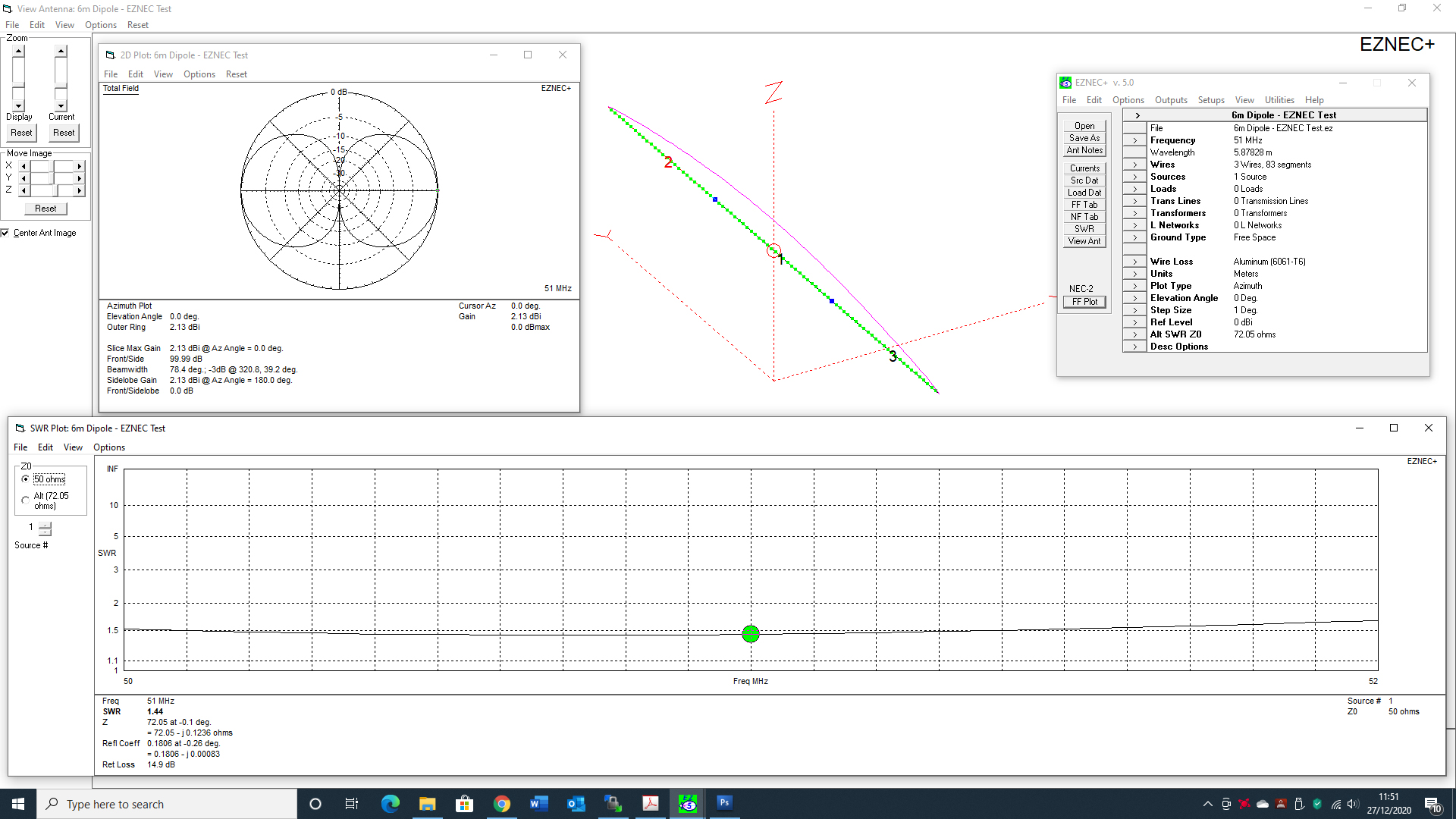
Based on 50 ohms so not ‘normalised’ or matched in any way in a ‘Free-Space’ environment.
For reference, the same antenna modelled at 1/2 wave above High Accuracy Ground – the plots had a very minimal change
EZNEC Pro/4 had an identical user interface to EZNEC Pro/2 and with virtually the same features except that it offers the additional options of internal single or double precision NEC-4.2 calculating engines. An NEC-4 license needed to be purchased from the NEC-4 copyright holder [Lawrence Livermore National Laboratory in the USA] before purchasing EZNEC Pro/4.
Although now legacy – this is what the route to Pro/4 was.
So you’re in the market to purchase a copy of EZNEC Pro/4′. Yes you could, but be ready to part with some serious $$. A copy of EZNEC Pro/4 was priced at $675.00 but then you require an additional copyright licence from the Lawrence Livermore National Laboratory in the USA. Last time we checked, that was another $500 for non-commercial use [Outside the US] on top of your $675 for the software. For the casual ham, these figures will be out of scope for most hobbyists and understandably so.
However, as there’s this big caveat when using EZNEC, most users will have copies of either EZNEC or EZNEC+. A handful of users may also have purchased EZNEC Pro/2.
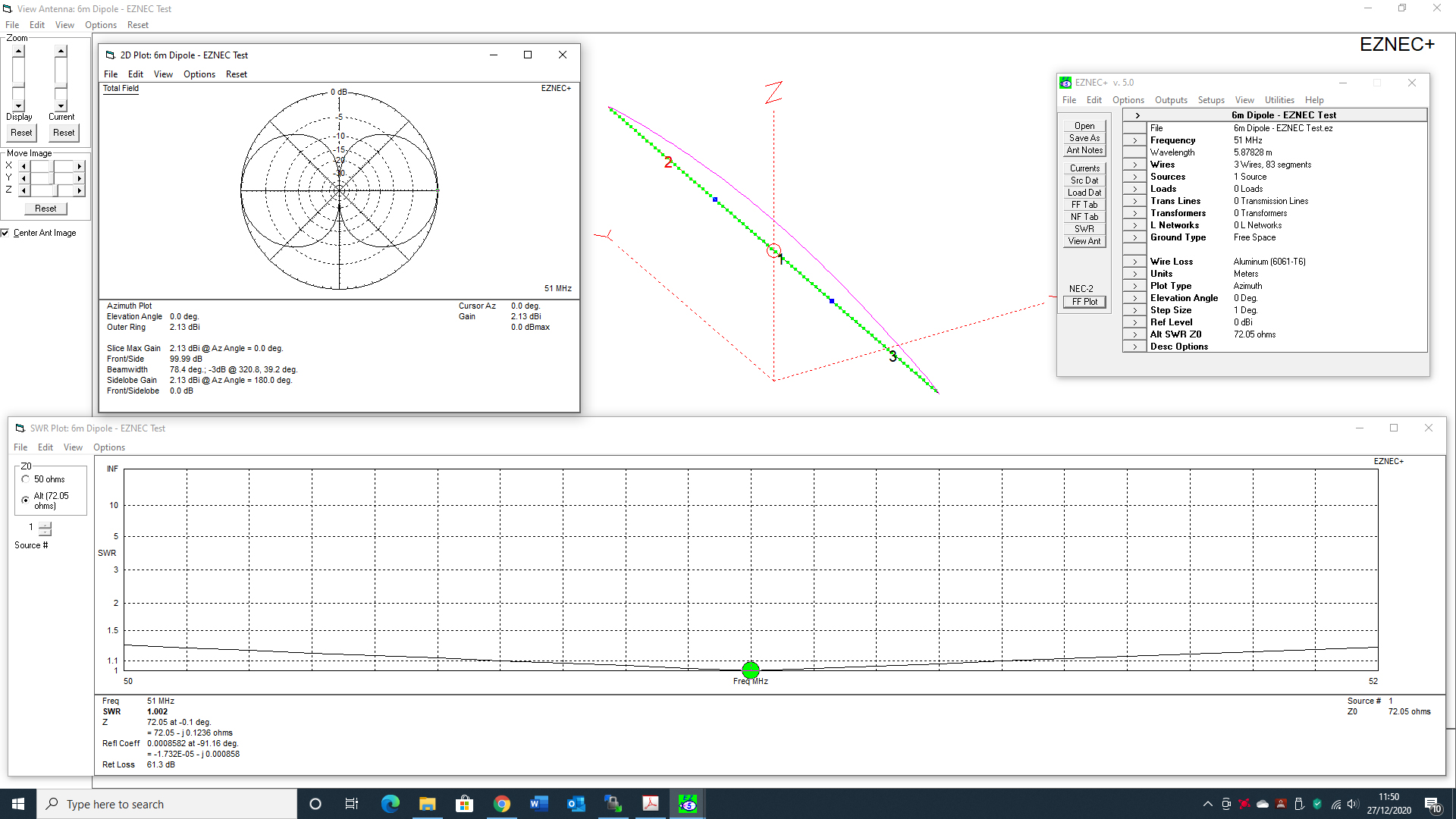
Based on 72.05 ohms and ‘normalised/matched’ in a ‘Free-Space’ environment.
For reference, the same antenna modelled at 1/2 wave above High Accuracy Ground – the plots had a very minimal change
The problem we found with software that runs the NEC-2 engine is that you don’t get the same accurate results as you would running EZNEC Pro/4. In most cases for HF, it’s close enough for ‘Amateur use‘ but move upwards into VHF and above and the amount of ‘error’ starts to increase. At 6m it’s enough to throw a model out by quite a reasonable amount.
On a personal basis and having used both the Pro/2 and Pro/4 versions – I found if you modelled with Pro/2 everything was resonant high. For example, I constructed a 10m dipole and modelled it in both ‘Free Space’ and also at 3m above average ground. In both cases, the expected ‘dip’ occurred about 600khz high in the band. One reason could be the accuracy of the NEC-2 calculating engine and another theory is that the ‘Stauff Clamps‘ have a capacitive affect on the antenna. Either way there was an error which needed to be allowed for.
What could be a problem for constructors [and we found out it was] – that once you started to build a beam antenna, then this shift in frequency could actually mess up the front to back ratio. See how we eventually got round the various limitations with the ‘Vortex VSA‘ further down in this article and how I eventually got our Delta Loop antennas working correctly.
Enter the ‘NEW’ 2022 Caveat – EZNEC+ and EZNEC Pro/2 Pro2+ Produce Different Results
OK – here’s a real weird one. Both EZNEC+ and EZNEC Pro/2+ have the same NEC/2 calculating engine [or that’s what the info says] and what I’m also led to believe. But there’s a problem…
I dropped the same file into EZNEC+, EZNEC Pro/2 and EZNEC Pro/2+ and got very different results. So why is this when they both use the same calculating engine. An email to W7EL went unanswered which wasn’t unexpected given that support has ended. Even so, something odd is happening..
Look at the below Tri-band Yagi. This is my own design for 20, 17 and 15m [It’s nothing like Optibeam’s version either which uses a 2:1 transformer]. It’s a 3 full size elements on 20 and 17 and 4 elements on 15m with a feed-point on the 20m driver. Take a look at the image below. It’s an SWR span from 14.000Mhz to 14.300Mhz using EZNEC+. Note the SWR curve.
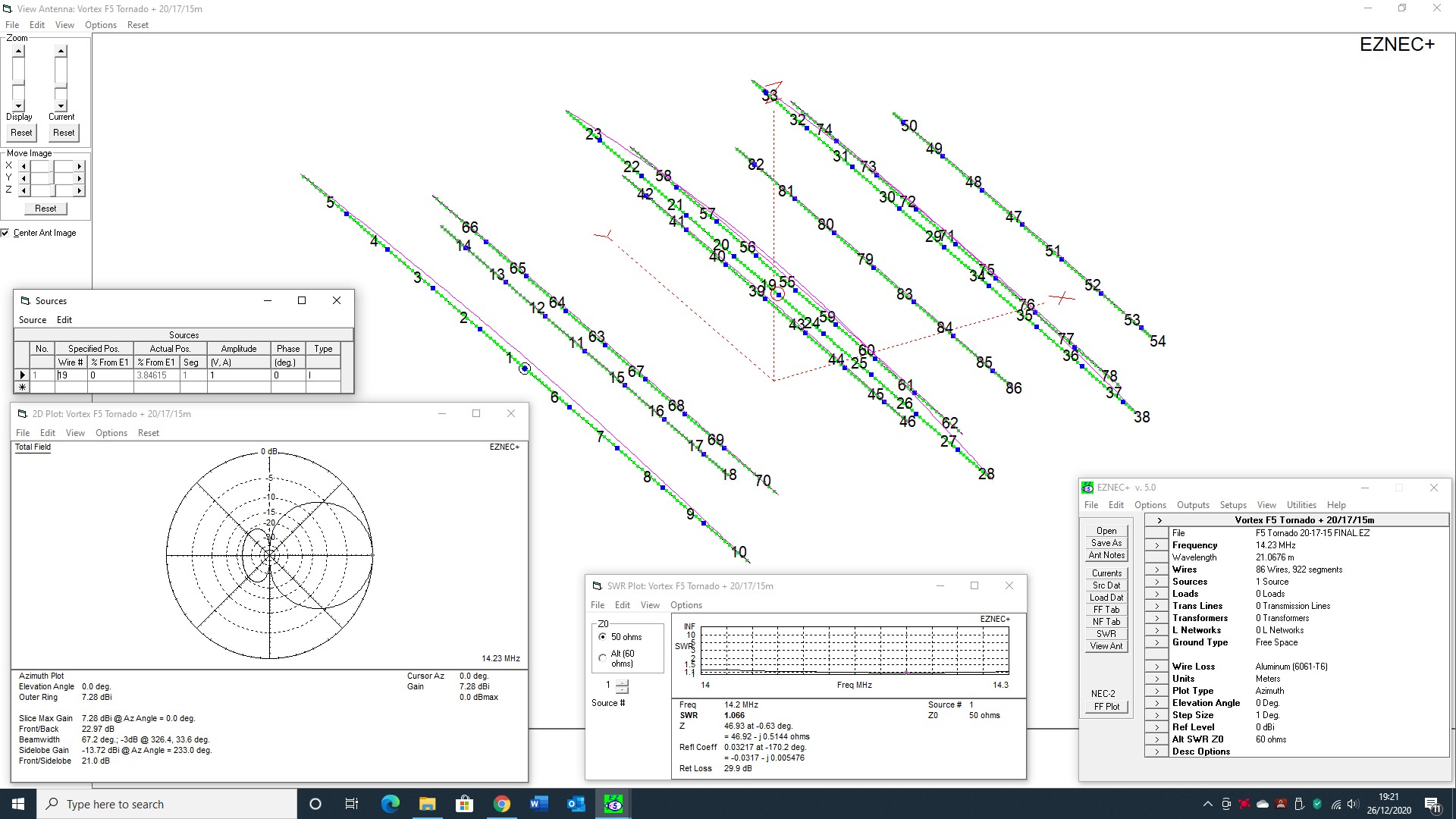
The SWR curve from 14.000MHz to 14.300MHz is very flat [SWR being under 1.2:1] over the whole band.
The total field plot with forward gain and front to back is based on a frequency of 14.230MHz
Here’s the exact same file dropped into EZNEC Pro/2 and EZNEC Pro/2+. So – why the [very] different SWR curve when [supposedly] both of these versions of EZNEC use the same NEC/2 calculating engine. Clearly they don’t – or there’s some Voodoo going on in Pro/2 and Pro/2+ that the user is not aware of. In practice I found that Pro/2 and Pro/2+ were much closer to the actual ‘final result’ that the antenna exhibited, especially on the SWR bandwidth curve.
For reference, the new free download is EZNEC Pro/2+ however, I have a copy of EZNEC Pro/2 downloaded in early January and the results were identical between the two. What does seem different is that there is a difference between EZNEC+ and EZNEC Pro/2+ when, if I’m not mistaken – use the same NEC2 calculating engine.
The SWR curve from 14.000MHz to 14.300MHz has changed significantly compared to EZNEC+
The total field plot with forward gain and front to back is based on a frequency of 14.230MHz
Note also that the antenna gain has now dropped below 7.00dbi – unfortunately we can’t verify if this is correct
At Vortex I was lucky enough back in 2010, to persuade my long time associate and software/electronics buff into putting his MSc to good use. He duly designed an 8 point [45 degrees] field-strength and data system. This was called our ‘Vortex Sensor Array’ [or ‘VSA’].
The VSA was later upgraded to 12 reference points [30 degrees] in 2012 and then to 16 reference points [22.5 degrees] in 2014. My associate wrote all the software and built the sensor array.
Data was fed back in a live stream [much more than just field-strength readings] to a laptop which we used on-site. You could effectively tweak any element and the sensors fed the figures back to us in ‘real-time’ so we could see what the change would make across the whole 360 degrees of the antenna.
At VHF, I found the accuracy of the NEC-2 engine questionable. An example Vortex 6m antenna did require re-tuning based on EZNEC Pro/2 models as the analyser results were off by quite an amount. However, our real-time sensor array was used to great effect in honing the design. I’ve never tried an NEC-2 engine design at UHF so can’t comment on the accuracy at this level.
Experienced users may comment that it’s the NEC-2 engine’s ‘Stepped Diameter Correction‘ algorithm that’s at fault. As an additional simple test, we used a single 16mm tube for the driver and arranged a split dipole centre just to see. Surprisingly, the results were the same as when we used the 12/16mm telescopic tubes. An interesting conclusion that will most certainly spur yet more debate.
Software Round-Up (Updated January 2022)
EZNEC: Legacy product not available [Discontinued]
EZNEC+: Legacy product not available [Discontinued]
EZNEC Pro/2: Was a freely available download in early January 2022 from EZNEC.com
EZNEC Pro/2+: The current freely available download from EZNEC.com
EZNEC Pro/4: Legacy product not available [Discontinued]
EZNEC Pro/4+: The current available download for NEC Pro/4 licence holders only from EZNEC.com
Optimisers:
There’s only one around as far as I know. In my opinion, EZNEC has always lacked a good optimiser although Dan Maguire’s AC6LA ‘AutoEZ‘ seems to work. I’ve tried the ‘Demo’ it but it needs time to get to grips with. IMO, the interface looks dated as it uses an old-school MS Excel based interface that seems more aimed at ‘Developers‘ rather than a slick end-user offering. Personally, I didn’t purchase it.
If you don’t like ‘Microsoft Excel‘ and working in formulas then you’ll hate it. However, the software is current and fully supported by the author with regular updates and enhancements. The current price is $79.
Summing up and observations:
I’ve had EZNEC+ [NEC-2 calculating engine] for many years and have built plenty of successful models with it. However as mentioned previously, the results obtained between EZNEC+ and EZNEC Pro/2+ differ and on the surface this shouldn’t be the case.
They both use the same NEC/2 calculating engine.
It’s anyone’s guess as to what is [really] going on and we’d be happy to hear any comments from experienced EZNEC users as to what they think is happening. As there’s’ no support anymore – we’re not expecting to get to the bottom of it.
As a PS – What’s even more odd
W7EL is actively promoting EZNEC Pro/2 V7+ and EZNEC Pro/4+ V7 [which look to be new versions] – has the author fully retired? …..we don’t think so!!
EZNEC Pro/2+ Software is available here from author Roy Lewallen W7EL
*LB Cebik: When MININEC is Superior to NEC
Prices listed were relevant in Dec 2020 [prior to EZNEC Pro/2 becoming ‘freeware’]
The views expressed here are purely that of the author [Steve – G0UIH]. None of the software packages listed in this article are either endorsed or recommended. The article is published purely as a reference based on the author’s own personal experiences with some of the packages listed above.

